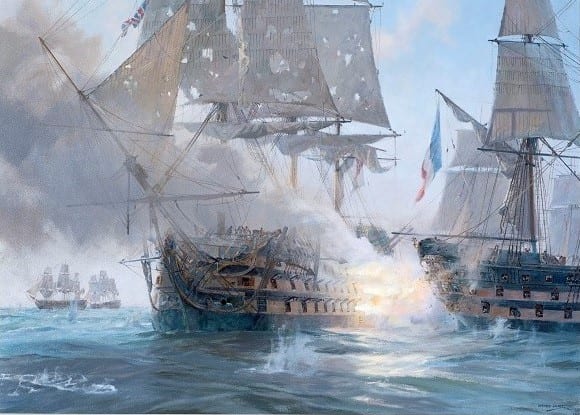
Geoff Hunt “The Deadly Blow” – HMS Victory at Trafalgar
Oil on Linen Canvas 26 x 36 inches (66 x 91.5 cm)
£36,000

Geoff Hunt “The Deadly Blow” – HMS Victory at Trafalgar
Oil on Linen Canvas 26 x 36 inches (66 x 91.5 cm)
£36,000
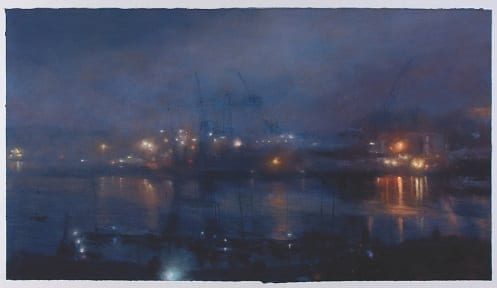
“Nocturne with Polluted Light (Part VI)”
Pastel on paper, 2019
32 1/4 x 58 inches (82 x 147.5 cm)
Signed
Framed
£8,400
Matthew Draper makes large and dramatic paintings using pastel. He studied at Falmouth College of Arts in the early 1990s and the extraordinary harbour there, the second-deepest natural harbour in the world, has inspired some of his most powerful paintings.
This powerful image shows a viewpoint from a promontory high above the harbour, overlooking the docks. The picture responds to the effects of both natural and man-made light in a place that contains both natural and industrial beauty. We see glimpses of the hulls of many different types of ships and vessels and of buoys and dockland cranes as well as chimneys and rooftops – linking the town and its working harbour together.
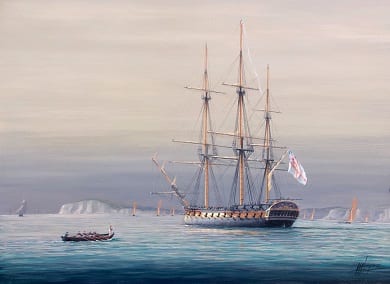
“Frigate at anchor in Whitecliffe Bay, Bembridge, Isle of Wight”
Oil on panel
11 x 15 inches (28 x 38 cm)
Signed, lower right
Framed
£5,250
A beautiful British frigate is seen at anchor in Whitecliffe Bay. Culver Cliff is seen in the distance to the left and the fishing fleet returns on a southerly breeze. A characteristic painting of a calm scene by Tim Thompson, with wonderful details.
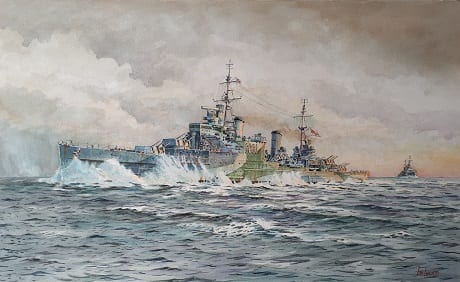
“The cruiser HMS Sheffield accompanied by HMS Jamaica at the Battle of the Barents Sea, 1942″
Watercolour and Body Colour on board
11 1/2 x 19 inches (29 x 48 cm)
Signed, lower right
Framed
£1,800
The painting shows the Town Class cruiser HMS Sheffield and the Colony Class cruiser HMS Jamaica at 11.34 on December 31st 1942, about to engage the German heavy cruiser Hipper during the Battle of the Barents Sea, December 1942. The battle was fought off the coasts of northern Norway and Russia in the middle of an Arctic winter.

“Loch Etive in fresh weather”
Acrylic on Canvas Board
16 x 20 inches (40.5 x 51 cm)
Signed and dated 75, lower left
Framed
£7,200
Conrad had passed his exam for second mate and obtained a post on the Loch Etive, a Loch liner, at the last minute for another voyage to Australia, leaving in August 1880. Some experiences in this ship found their way into his novel “Chance”.
This lovely painting is one of a group of twelve painted by Mark Myers in 1975 to illustrate a manuscript on Conrad’s maritime life by Alan Villiers. Mark served at sea under Alan Villiers and remained devoted to him. The book was finally published in 2006 by Alan’s son Peter Villiers. Entitled “Joseph Conrad: Master Mariner” it is an enthralling account of Conrad’s extensive maritime service, touching on its influence on his stories and writing. Mark Myers’ paintings are beautifully reproduced in the book, bringing out the extraordinary clarity and detail he achieved in each work.
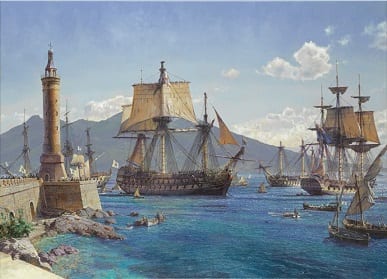
“The Conquering Hero: Admiral Sir Horatio Nelson’s victorious flagship HMS ‘Vanguard’ towed into Naples by HMS ‘Thalia’, 22nd September 1798 after The Battle of The Nile”
Oil on Linen Canvas
26 x 36 inches (66 x 91.5 cm)
Signed, lower right
Framed in a hand-finished gold frame with white gesso slip
£27,000
Maarten Platje has recreated one of the great moments in the extraordinary life of Horatio Nelson in the aftermath of one of the greatest and most important British naval victories.
After his stunning victory over the French fleet at The Battle of The Nile Rear Admiral Sir Horatio Nelson was about to become the most famous and dashing British naval hero. He would be ennobled by Britain and showered with titles and honours by many other countries. However his flagship at the battle, HMS Vanguard, had been terribly damged not only by the battle but also by two severe storms. Thus the flagship of the victor of The Nile had to be towed into Naples by the beautiful frigate Thalia for repairs. This is the scene Maarten has painted; to the left can be seen a ship of the Royal Neapolitan Navy, flying their flag and in the right background is a badly damaged British ship, the Alexander, awaiting repair. A lovely Royal Neapolitan barge, also flying their flag, approaches Vanguard. The British flagship flies a white ensign because Nelson, although an admiral of the blue, had ordered white to be flown in the battle, believing them to be more easily recognisable.
Yet this day was highly important for Nelson apart from the glory of his victory, for it was on this day that he met Emma Hamilton again and their famous affair was kindled. Naples was in wild and ecstatic celebration of the victory and Emma, wife of the British Envoy Sir William Hamilton was almost mad with excitement. She and Sir William went out in the Royal Barge with King Ferdinand IV of Naples and the Royal Family to greet the returning hero and it is reported that Emma fainted clean away on meeting Nelson.
Maarten Platje has succeeded in uniting several strands in this exceptional and lovely painting. There is the meticulous rendering of these beautiful and intricate ships (the detail in this painting is incredible and should be studied closely); the depiction of the exotic old harbour in strong sunlight; a very interesting presentation of the other side of warfare, showing the terrible damage inflicted on ships by enormous guns and powerful storms; and alongside this is a brilliantly rendered sense of human emotions, because we know that this day, as well as a celebration of victory, was the start of one of the world’s most famous love affairs.
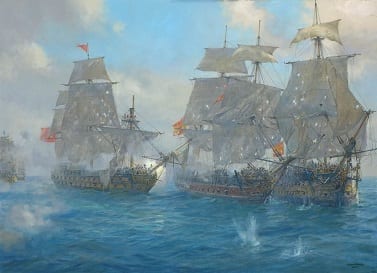
“Nelson’s Patent Bridge for Boarding First Rates”
Oil on linen canvas
26 x 36 inches (66 x 91.5 cm)
Signed and dated, lower right
Framed in a hand-finished gold frame with white slip
£31,200
Here Geoff Hunt has painted one of the pivotal points in Nelson’s life. It is the moment that first brought the name of the young Commodore to the notice of the public and his superiors in the Navy and contributed to what became the Nelson legend. Nelson was knighted for this extraordinary action.
The action took place at The Battle of Cape St. Vincent on the 14th of February 1797. Nelson was in command of the 74-gun HMS Captain. He took Captain out of the line, many believe defying orders, and enaged several enemy ships, including the giant 136-gun Santisima Trinidad. With Captain badly damaged, Nelson engaged the 80-gun Spanish ship San Nicolas. This ship’s rigging became entangled with that of the enormous 112-gun San Josef and Nelson boarded and captured first San Nicolas and then San Josef, having effectively used San Nicolas as a bridge to reach San Josef ; the action became immortalised as “Nelson’s Patent Bridge for Boarding First Rates”.
In Geoff Hunt’s wonderful painting we see the badly-damaged Captain, on the left, closing with San Nicolas who in turn is already dangerously close to the huge San Josef. At the prow of Captain can be seen a slight figure, waving a sword in his right hand as he prepares to board. This is Nelson himself, who left an account of boarding the first ship through her stern windows and shooting his way out to storm on and capture San Josef. A few months later Nelson was to lose his right arm in the disastrous action at Santa Cruz de Tenerife. The shell splashes in the foreground come from HMS Prince George, which was bombarding the Spanish ships until Captain had to ask her to stop, and on the extreme left of the painting may be seen a glimpse of the great British flagship HMS Victory.
This paintng perfectly sums up Nelson’s famous sentiment that “No Captain can do very wrong if he places his Ship alongside that of an Enemy and boards her in the smoke”.